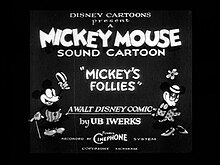Mickey's Follies
| Mickey's Follies | |
|---|---|
 | |
| Directed by | |
| Produced by | Walt Disney |
| Starring | Walt Disney |
| Music by | Carl Stalling |
| Animation by | Ub Iwerks |
| Color process | Black and white |
Production company | |
| Distributed by | Celebrity Productions |
Release date |
|
Running time | 6 minutes |
| Country | United States |
| Language | English |
Mickey's Follies is a Mickey Mouse animated short film first released on August 28, 1929, as part of the Mickey Mouse film series. It was directed by Ub Iwerks and Wilfred Jackson, with music by Carl Stalling. It was produced in black and white by The Walt Disney Studio and released to theaters by Celebrity Productions.[2] It was the tenth Mickey Mouse short to be produced, the seventh of that year.[3]
This cartoon revolves around Mickey singing the song "Minnie's Yoo-Hoo", which was later used as the opening theme for all of the Mickey Mouse cartoons from The Jazz Fool (1929) until Mickey's Steam Roller (1934).[2] Mickey's singing voice is provided by an anonymous studio employee; in these early days, Walt Disney was not yet the exclusive voice for Mickey.[1][4]
Plot
[edit]The animals in the barnyard are watching a series of short song and dance numbers performed by other barnyard animals, similar to the Ziegfeld Follies of the day. It opens with Mickey playing the piano with other animals. A series of other short song and dance numbers presume. The cartoon ends with Mickey giving a solo performance of his theme song.
Along with Mickey, Minnie Mouse is shown in the audience cheering for Mickey. There is also a cast of other barnyard animals, including a group of dancing ducks, a chicken-rooster duo who beat each other up in sync to the music, an operatic singing pig who is poorly received, and various other barnyard animals in the audience.
Reception
[edit]
In Mickey's Movies: The Theatrical Films of Mickey Mouse, Gijs Grob writes: "Mickey's Follies is Disney's second serious attempt at lip synch, after The Karnival Kid. Mickey sings much more than in the former cartoon, and the all-too-literal mouth movements give him many awkward facial expressions. Later, the animators would learn to tone down the mouth movements, keeping Mickey's face more consistent without losing the illusion of speech."[2]
Motion Picture News (September 14, 1929): "Walt Disney's creation, the popular Mickey Mouse, sings and dances in a typical barnyard frolic, which is the tenth of the series of Mickey films. Strictly speaking, it is not as good as some of its predecessors, but it certainly contains plenty of laughs, nevertheless. One of the weak spots in the film is the injection of a theme song sung by Mickey Mouse; it seems rather flat. Another thing to notice was the cartoon work, which was not executed with the nicety that some of the other cartoons have. However, the laugh material far outburdens the few shortcomings. The animals have a grand time and the fun is shared by the audience. Some of the barnyard folk are sitting on an outhouse, and in their ecstacy over Mickey's performance they crash in the roof. Immediately the door opens and a pig runs out with his pants down. Can you imagine? Movie audiences relish this sort of screen fun, and Mickey's Follies is supplied with enough laughs to make them gurge heartily and long."[5]
Home media
[edit]The short was released on December 2, 2002 on Walt Disney Treasures: Mickey Mouse in Black and White.[6]
See also
[edit]References
[edit]- ^ a b Kaufman, J.B.; Gerstein, David (2018). Walt Disney's Mickey Mouse: The Ultimate History. Cologne: Taschen. p. 43. ISBN 978-3-8365-5284-4.
- ^ a b c Grob, Gijs (2018). "Mickey's Follies". Mickey's Movies: The Theatrical Films of Mickey Mouse. Theme Park Press. ISBN 978-1683901235.
- ^ Lenburg, Jeff (1999). The Encyclopedia of Animated Cartoons. Checkmark Books. pp. 108–109. ISBN 0-8160-3831-7. Retrieved June 6, 2020.
- ^ "Hit the Beach (Part 1)". cartoonresearch.com. Retrieved July 24, 2021.
- ^ Ganly, Raymond (September 14, 1929). "Opinions on Pictures". Motion Picture News: 989. Retrieved February 23, 2020.
- ^ "Mickey Mouse in Black and White DVD Review". DVD Dizzy. Retrieved February 19, 2021.
External links
[edit]- 1929 films
- 1920s Disney animated short films
- 1929 animated short films
- 1929 comedy films
- Films directed by Ub Iwerks
- Films directed by Wilfred Jackson
- Films produced by Walt Disney
- Mickey Mouse short films
- Films scored by Carl Stalling
- Cockfighting in film
- American animated short films
- 1920s English-language films
- 1920s American films
- Animated films set on farms
- English-language short films
- American animated black-and-white films
